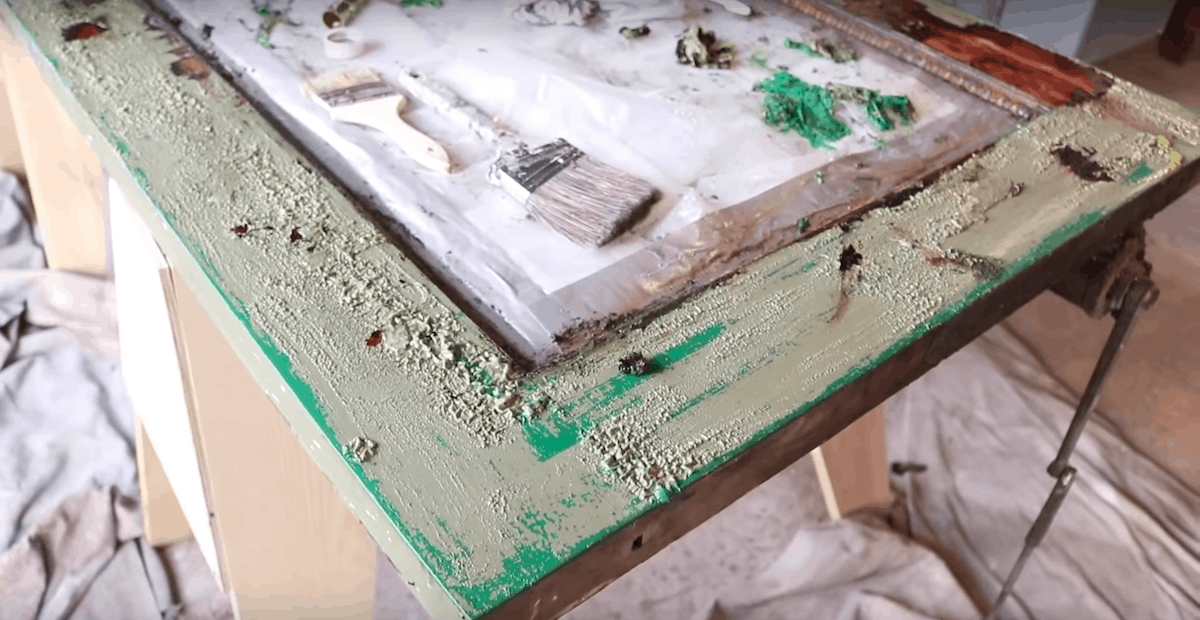Stripping paint can be a tedious, time consuming process. Fortunately, having the best paint stripper at your disposal can alleviate this problem.
Whether you want to spruce up an old piece of furniture with a fresh coat of paint, to customize a new find to perfectly match your space, or refinish surfaces in your home, using a good paint stripper first will create the blank canvas you need to do the job well.
Though often a tedious job, removing the layers of paint and stains that have built up over time can do wonders for your furniture, leaving it rejuvenated and restored.
Below is our comprehensive list of the paint strippers currently available on the market. Let's take a look.
Quick Overview: Our Best Paint Stripper Choices
[sc name="Best Paint Stripper"]
Citristrip QCSG801 Paint & Varnish Stripping Gel (2 Pack)
No products found.
Citri-Strip Paint and Varnish Stripping Gel is well deserving of its top spot in this buying guide. Its affordability, versatility and relative safety make it an excellent choice for most paint-stripping needs.
One of the best things about Citri-Strip is that it doesn't smell like a chemical overload; instead, it smells like (artificial) oranges. This allows you to use it indoors without feeling like you're going to pass out, which is great if your climate or living arrangement keeps you from removing paint and varnish outside.
It also doesn't contain any methylene chloride (DCM), which is true for all of the products in this buying guide.
Another great thing about Citri-Strip is that it is very easy to use. Paint remover usually only works if it stays wet, which can be a hassle because you usually need to let it sit overnight. This one stays wet for 24 hours with no assistance, which means you can set it and forget it until it’s time for removal.
Its bright orange color is also a huge help because it stands out (unless you’re trying to remove bright orange paint), making it easy to tell if you missed any spots.
This isn’t the strongest or fastest paint stripper out there, but its ease of use and convenience make it a great product. For those who want one paint thinner that will easily work for various jobs, Citri-Strip is a winner.
Things We Like:
- Strips multiple layers
- Stays wet up to 24 hours
- A powerful, industrial-strength remover
- Safe for indoor use
- Removes latex and oil-based paint, varnish, lacquer, stains, and more
- Biodegradable
- Citrus Scent
Things We Don't Like:
- You really can't go wrong with this option
Blue Bear SOYGel Professional Paint Stripper
No products found.
As the name suggests, SOY Gel is made from soybeans, 100 percent of which are grown in the USA. This powerful paint stripper is a great choice for the safety and environmentally-conscious, as it is completely biodegradable and has no known health hazards.
It’s made by Franmar Chemical, a company with a 25-year history of developing effective, economical and safe cleaning solutions from soybeans and natural elements.
This product works well on a wide range of surfaces and coatings including urethanes, enamels, and sealers, but it is particularly effective for latex-based paints.
SOY Gel is easy and convenient to use--one application will remove multiple layers, and it doesn’t have a strong smell.
Things We Like:
- Removes Paints, Urethanes, Enamels, Sealers, Some Epoxies, and Many Other Coatings
- Biodegradable
- Made from 100% American soybeans
- Removes multiple layers of coatings in one application
- Safe for Use Indoors
Things We Don't Like:
- A bit sticky and messy
Dumond Chemicals, Inc. 7001 Peel Away 7 Solvent-Based Paint Remover
No products found.
Dumond Peel Away 7 is a solvent-based paint remover that makes stripping oil-based paint a breeze. It's very versatile, safely and effectively removing most high-performance coatings and finishes from both interior and exterior surfaces (including wood, brick, stone, plaster, metal and more) it excels at removing oil-based paint from wood surfaces.
Its formula contains no methylene chloride (DCM) or caustic chemicals, and it is pH neutral, making it a highly recommended choice for historic restoration.
Peel Away 7 is made by Dumond Chemicals, a company well known for creating environmentally safe solutions for coatings removal and lead abatement. You’ll see them a few more times in this buying guide.
Things We Like:
- Can be used in a temperature range of 40-90 degrees F
- Does not contain methylene chloride or caustic chemicals
- Ideal for wood substrates because it won’t discolor or raise the grain
- User-friendly and ph neutral; does not require neutralization
Things We Don't Like:
- Really only ideal for oil-based paints
Formbys 30013 Furniture Refinisher
Last update on 2024-05-09 / Affiliate links / Images from Amazon Product Advertising API
If you’re looking for a product created specifically to remove old stains, varnishes, lacquer, and shellac from wood without damage, Formby’s Furniture Refinisher is a great option.
This refinisher was created to restore beautiful patinas and finishes to antique furniture without having to risk damage by sanding them down or scraping them.
It also conditions wood with natural oils, leaving your furniture looking better than ever and protecting it from drying and cracking. It’s very easy and convenient to use--all it needs is a quick wipe off with some fine steel wool, and then finish your furniture off with some Tung oil for protection.
Things We Like:
- Easily dissolves old varnish, lacquer, and shellac
- No sanding or scraping necessary
- Great for removing stains
Things We Don't Like:
- Requires tung oil application at the end of it's use
Dumond Smart Strip Advanced Paint Remover
Last update on 2024-05-09 / Affiliate links / Images from Amazon Product Advertising API
This eco-friendly paint stripper is a no-brainer for indoor and outdoor use. The Smart Strip Advanced Paint Remover is a 100% biodegradable, water-based paint stripper that uses Benzyl alcohol to get the job done.
It can effectively remove multiple layers of architectural and industrial coatings from so many different surfaces--wood, brick, metal, concrete, stone, plaster, and most fiberglass and plastics included.
One coat can remove up to 15 layers of paint, and its easily spreadable consistency makes it easy to brush, roll, or spray on to pretty much any surface (including vertical!)
Things We Like:
- Removes multiple layers
- Odor free
- Safe for removal of lead-based paint
- Works well on intricate, carved, or molded surfaces
- Removes marine paints without damaging the gel coat
Things We Don't Like:
- Creates a bit of a mess
- Pricier than other options
Features to Consider
Knowing Your Surface
First, consider if a paint stripper is the right paint removal technique for your project. For some larger, immobile projects like baseboards and siding, heat may be the best way to go.
For hardwood floors and larger pieces of furniture with flat, even surfaces, sanding is usually the recommended method. However, if the surfaces of your furniture are bumpy and uneven, you probably need to use paint stripper.
Additionally, paint stripper is a great choice for furniture or interiors with intricate details or awkward shapes. You can also use it to finish up a job that’s been mostly completed with heat or sanding, using the paint stripper to clean up the small areas or corners you may have missed.
Safety
Safety is a very important thing to take into consideration when working with paint stripper. Many chemical paint strippers sold in the USA contain a substance called methylene chloride (also known as dichloromethane, or DCM), which is favored for its strength and speed.
However, DCM is widely accepted to be hazardous. Short term, DCM fumes can temporarily reduce the blood’s capacity to carry oxygen and leave you feeling dizzy and short of breath. Prolonged exposure to DCM, either through the lungs or skin, has been linked to liver failure, kidney damage, and cancer.
The fumes from DCM are often very strong and can even overpower air-purifying ventilation systems. For these reasons, we recommend avoiding paint strippers with DCM.
Even with safer alternatives, you should always take precautions when working with chemical paint strippers to protect yourself and your home. To start, always make sure to wear impervious gloves and eye protection.
Lastly, and importantly, if you suspect you may be working with lead paint, it's best to do extra research and/or contact a professional to ensure safe handling.
Types of Paint Strippers
Paint stripper is not a one-size-fits-all kind of product--it’s really important to get the right kind of paint stripper for your specific job.
There are three main categories of paint strippers: caustic, solvent, and biochemical, but there is additional variation within these categories as well. Always read the labels and make sure you pick the right product for your project.
Caustic
These paint strippers use lye to essentially turn the top layer of paint into soap, creating a chemical reaction that loosens the paint from its surface. Lye is made from either caustic soda (sodium hydroxide) or caustic potash (potassium hydroxide).
These strippers will remove most latex and alkyd paints, but they have to remain on the surface for at least a few hours. Though they're slower than other solvents, they're also associated with fewer health risks. The most common risks are skin burns or lung irritation, but these are mitigated by proper gloves, clothing, and ventilation.
One downside to caustic solvents is that they do often darken the wood, which means you'll have to bleach your furniture too if you plan on staining it a lighter color. Also, they work best at temperatures over 50 degrees F.
Solvent
Paint strippers utilizing chemical solvents as their active ingredient remove paint by weakening or dissolving the bond between the layers of paint or stains, which causes the coating to bubble up and peel or scrape off.
As mentioned above, one type of solvent is methylene chloride (DCM), but it is not recommended due to associated health risks.
Other types of solvents include ones using N-methyl-2-pyrrolidone (NMP), alcohol, toluene, acetone, methanol, and/or ketones. Though these options have fewer associated risks, they should still be used with caution--be sure to read and follow all safety information on the bottle!
Biochemical
Biochemical-based paint strippers are similar to chemical solvents, but they use solvents derived from plants.
Some common ones are lactic acids made from corn sugars, pine or citrus terpenes, citric acid, dimethyl sulfoxide (DMSO) made from paper by-products or wood pulp, and soy oil.
Associated risks with these are minor, but they can cause skin irritation and should still always be used in a well-ventilated space. Sometimes these products use NMP in addition to the biochemical agents.
Wrap Up
When it comes to stripping paint, it is of utmost importance that you not only stay safe, but get a reliable paint stripper that actually does it's job without all of the added toxic chemicals.
There is also the matter of what surface needs the paint removal needed. Depending on what kind of paint is being removed and the surface from which it is being removed from, you may want to make a different selection.
All of the options on this list do just that, but our choice for the best paint stripper is without a doubt the Citi-Strip Paint and Varnish Stripping Gel, which offers maximum strength stripping abilities along with a scentless application. If you're interested, you can check it out here.




